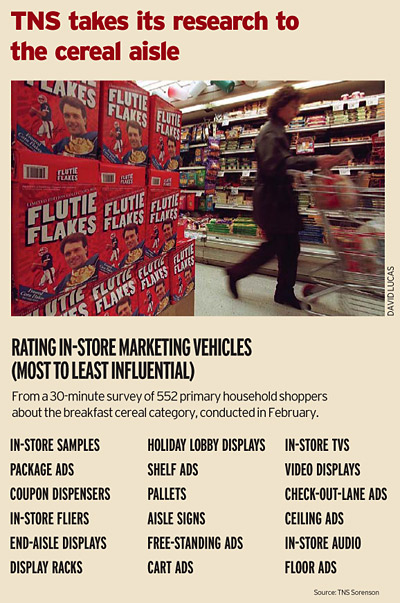
Old school in-store media kicks new stuff's shiny butts, says Soreson research
April 15, 2008 by Dave Haynes

Bill Gerba picked up on this already but I will continue, driving home some research that will hopefully start to influence some decisions around in-store media.
At that conference in Montreal last week, a guy from one of Canada’s biggest agencies casually asked me who in retail was doing a really good job of in-store digital media. Nothing jumped right to mind, though there are certainly efforts here and there I think are well done.
Most of it isn’t, however, because the screens are in the wrong places and/or the content mix is wrong or just plain silly.
New research by TNS Sorenson confirms the more established trickery of in-store promos, like product sampling and coupons, still goes over much bigger with shoppers.
According to a piece in Ad Age, some of the more-established mainstays of category promotion, such as in-store sampling and instant-coupon machines (from News Corp.’s SmartSource) resonated well with consumers in surveys. But some applications more like traditional media advertising, including in-store TV and floor ads, fared worse.
The study gave high marks to on-pack advertising because of the billboard-like nature of cereal boxes. But many of the results are similar to what TNS has found in other categories, said James Sorenson, exec VP-retail and shopper insights for TNS Sorenson.
The research was done in February, in the US, and involved interviews with 552 shoppers. It looked at 19 specific in-store media types.
The in-store programs found “most influential” by consumers in the study were, in order, in-store samples, package ads, coupon dispensers, in-store fliers and end-aisle displays. Those deemed least influential were ceiling ads, in-store audio and floor ads. Most of the newer media — including cart ads, in-store TVs, video displays, checkout-lane ads and entryway ads — ranked in the lower half of the 19 media considered.
Relevance is key to any media working in-store, Mr. Sorenson said, so the more closely aligned the ad is with the category and product, the better.
Logistically, he added, a lot of newer in-store media are out of place because the best place to get a shopper’s attention is about 40 inches above the floor, not on the floor or dangling from the ceiling.
Just being influential doesn’t necessarily make a medium effective, either. Sampling usually does well in consumer surveys, but it’s so expensive that it’s hard to deliver a positive return on investment, he said, adding that some media found less influential could in the end be more effective if they’re less cluttered by competitive advertising.
As Bill points out, this all has to be taken with a grain of salt because much of the media that tested well has been around for many years and countless lessons have been learned. We’re still largely in figure-it-out-as-we-go mode, though I’ll never know how putting a screen up at the same height as an NBA backboard made a bunch of sense.
Shoppers are also, quite naturally, going to associate more value with free food and drinks, and money-saving coupons, than they are with screens in their store giving them news on the latest roadside IED in Iraq.



[…] designs from Dubai, Delhi, London, Shanghai and Las Vegas. Should Blockbuster buy Redbox? Old school in-store media kicks new stuff’s shiny butts, says Soreson research Bill Gerba picked up on this already driving home some research that will hopefully start to […]